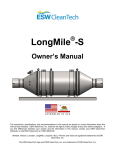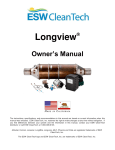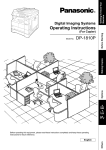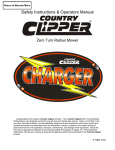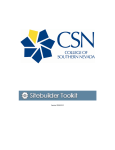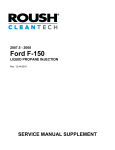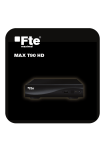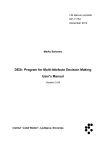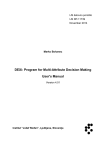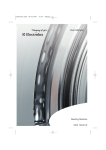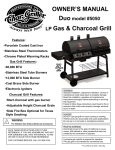Download PDF
Transcript
® Horizon Owner’s Manual ATTENTION: Keep a copy of this Owner’s Manual in the vehicle at all times. The instructions, specifications, and recommendations in this manual are based on current information when this manual was released. ESW CleanTech, Inc., reserves the right to make changes at any time without obligation. If you find differences between your system and the information in this manual, contact your ESW CleanTech, Inc. dealer or call ESW CleanTech, Inc. at 1-800-398-6105. Allmetal, Horizon, Lonestar, LongMile, Longview, MLC, Phoenix and Vista are registered trademarks of ESW CleanTech, Inc. The ESW CleanTech logo and ESW CleanTech, Inc. are trademarks of ESW CleanTech, Inc. This page intentionally left blank ESW CleanTech, Inc. Horizon® Owner’s Manual Table of Contents General Information.................................................................................................................................................. 1 Cautions............................................................................................................................................................. 2 Safety Warnings ................................................................................................................................................ 2 Owner’s Legal Obligations................................................................................................................................. 3 Contact Information ........................................................................................................................................... 3 Installation ......................................................................................................................................................... 4 Engine Repower ................................................................................................................................................ 4 Acronyms ........................................................................................................................................................... 5 Horizon System Description.................................................................................................................................... 6 Product Summary .............................................................................................................................................. 7 PM Filter Assembly............................................................................................................................................ 8 Control System .................................................................................................................................................. 9 Low-Voltage Switch (Optional) .......................................................................................................................... 9 Regeneration System ...................................................................................................................................... 10 CARB-Verification Labels ................................................................................................................................ 11 Operations ............................................................................................................................................................... 12 Driver Notification Lights.................................................................................................................................. 13 Regenerating the Horizon................................................................................................................................ 17 Pay Attention to Horizon, Engine and Vehicle................................................................................................. 17 Conditions That May Damage the System ...................................................................................................... 18 Maintenance and Repair ........................................................................................................................................ 19 Your Right to Maintenance Information ........................................................................................................... 20 The Importance of Engine Maintenance ......................................................................................................... 20 The Importance of Properly Maintaining a Diesel Emission Control Strategy ................................................ 20 Maintenance Schedule .................................................................................................................................... 20 Preventative Maintenance ............................................................................................................................... 21 Service Calls .................................................................................................................................................... 23 Parts List .......................................................................................................................................................... 24 Troubleshooting Table ..................................................................................................................................... 25 Repair and Maintenance Clarifications............................................................................................................ 26 Engine Oil Consumption and Lube Oil Ash ..................................................................................................... 27 Specifications ......................................................................................................................................................... 29 Owner’s Obligations ............................................................................................................................................... 31 Warranty .................................................................................................................................................................. 33 Product Warranty............................................................................................................................................. 34 Installation Warranty ........................................................................................................................................ 35 ESW CleanTech, Inc. Warranty Clarifications ................................................................................................. 35 CARB Executive Order for the Horizon ................................................................................................................ 36 Horizon_Owner's_Manual ESWCT-2013-07-09 GENERAL INFORMATION Horizon_Owner's_Manual ESWCT-2013-07-09 Page 1 Cautions Please study this manual and understand the requirements for the ESW CleanTech, Inc. Horizon system before operating your vehicle. The pictures and descriptions in this manual are for a typical Horizon system. Some parts, components and configurations for your particular system may vary from those shown here depending on the vehicle and application. The use of parts which are materially different than the verified retrofit parts or systems may void the verification and the warranty. The owner’s obligations, routine observations and periodic maintenance requirements are described in this manual. Contact an ESW CleanTech, Inc. authorized dealer if you need further assistance. Safety Warnings Before starting regeneration, park the vehicle in a well-ventilated location far away from any combustible material. Turn the engine off. Do not regenerate indoors. The system may be hot when not normally expected: During regeneration, the engine will be off, but the Horizon (including the downstream pipes) will be very hot. Do not touch any of the PM filter assembly components or exhaust tubing during regeneration or after engine operation. All surfaces can become hot and may cause burns. The PM filter stays hotter much longer than a stock muffler will after operating under heavy load, after the engine is turned off, and after a completed regeneration cycle. After operating under heavy load (for example, driving up to a mountain pass), the driver should be very careful if they need to pull off to the side of the road and leave the engine idling. The PM filter retains heat much longer than a muffler which makes it possible for very hot exhaust gases to exit the tailpipe for several minutes and be a potential source of ignition for combustible material (such as dry grass). Do not allow combustible material from the working environment to come in contact with the Horizon (for example, paper, trash, sawdust). The Horizon’s regeneration system uses high voltage (up to 240-volt nominal, single-phase alternating current (AC); see the “Specifications” on page 29). Only a technician qualified to work with alternating current of this voltage should install or repair any of the AC electrical components. Horizon_Owner's_Manual ESWCT-2013-07-09 Page 2 Owner’s Legal Obligations Use of any alternative diesel fuels and or fuel additives not specifically listed in the CARB verification Executive Order (E.O.) is illegal and strictly prohibited. Operating with an unapproved alternative diesel fuel or fuel additive violates the E.O., negates the verification for that engine, and removes compliance status for the vehicle. The end-user must meet other requirements in the E.O. for the Horizon which is provided in this manual beginning on page 36. The E.O. for the Horizon may also be obtained from the CARB website at http://www.arb.ca.gov/diesel/verdev/level3/level3.htm. The installation of the Horizon is based on the owner’s understanding that adding a new part to or altering an original part of a certified configuration could be considered a violation of the tampering prohibition of the Clean Air Act. The owner understands that the installation of the Horizon will not violate tampering provisions of the Act, at the time of installation, because of the testing performed under the verification process—provided that the owner adheres to all installation instructions and meets all operating and maintenance requirements for the Horizon. Specific events that require action by the owner or operator are given in the “Owner’s Obligations” section on page 31. If any of these events occur, it is the owner’s obligation to take the appropriate action. Failure to do so may be the basis for denying a warranty claim. Contact Information Contact an ESW CleanTech, Inc. -authorized dealer for any sales or service support for your Horizon system. The tables below for contact information are provided for the customer to complete at their convenience. For more information, contact your local ESW CleanTech, Inc. product support representative, call ESW CleanTech, Inc. at 1-800-398-6105, or visit eswgroup.com. Dealer Address Contact person Contact person’s phone Contact person’s fax Contact person’s email Horizon_Owner's_Manual ESWCT-2013-07-09 Page 3 Name of local ESW CleanTech, Inc. product support representative Local ESW CleanTech, Inc. representative’s phone Local ESW CleanTech, Inc. representative’s email Installation ESW CleanTech, Inc. recommends that an ESW CleanTech, Inc. -authorized technician install the Horizon system. The complete installation procedures are described in the Horizon Installation Manual. Copies of the manual are available upon request from your dealer or ESW CleanTech, Inc. The installation warranty (page 35) is the responsibility of the dealer that installs the Horizon system. Note: the power-supply station installation is the responsibility of the customer and their electrical contractor. Copies of the Power-Supply Station Installation and Maintenance Guide are available upon request from your dealer or ESW CleanTech, Inc. . Attention: A ESW CleanTech, Inc. -certified technician must commission the system; otherwise, that may be the basis for denying a warranty claim. Warranty registration is submitted by the ESW CleanTech, Inc. -authorized dealer. Engine Repower A DECS installed on a vehicle that is repowered may remain installed provided: The replacement engine meets all the terms and conditions of the governing Executive Order or conditional verification letter, The DECS is not more than ten years old (based on the date of manufacture), and The appropriate DECS engine label is affixed to the replacement engine in a visible location. Horizon_Owner's_Manual ESWCT-2013-07-09 Page 4 Acronyms AC BP CARB CO DC DECS DPF HC LED MLC® MLinC OEM PM TC ULSD VAC VDC alternating current backpressure California Air Resources Board carbon monoxide direct current Diesel Emissions Control System diesel particulate filter hydrocarbons light emitting diode (system indicator light) the electronic controller in the Horizon system the software program used to communicate with the MLC original equipment manufacturer particulate matter (diesel soot) thermocouple ultra-low sulfur diesel fuel volts alternating current volts direct current Horizon_Owner's_Manual ESWCT-2013-07-09 Page 5 HORIZON SYSTEM DESCRIPTION Horizon_Owner's_Manual ESWCT-2013-07-09 Page 6 Product Summary The Horizon has been verified by the California Air Resources Board to capture over 85% of the particulate matter (PM) from diesel engine exhaust (“Level 3 plus”). Features include: Stainless steel construction Particulate matter filter (PM filter) Modular design to facilitate installation, service and maintenance Filter regeneration when the vehicle is parked (5-hour regeneration cycle) ESW CleanTech, Inc. MLC (the system controller) Sound attenuation eliminating the need for a muffler or silencer The Horizon (Figure 1) consists of three main subsystems: the PM filter assembly, the control system, and the regeneration system: The PM filter captures over 85% of the particulate matter (soot) from the diesel engine exhaust while the vehicle is operating. The control system monitors the Horizon and engine during operation and controls the regeneration cycle, which cleans out the PM filter. The regeneration system operates while the vehicle is parked and plugged into AC power. Figure 1: Horizon system schematic drawing. Horizon_Owner's_Manual ESWCT-2013-07-09 Page 7 P PM Filte er Asse embly T The PM filte er assembly (Figure 2) 2 is the corre of the H orizon systtem and it usually will replace tthe muffler. The assem mbly has im mportant fea atures high hlighted belo ow: Figure F 2: PM P Filter As sembly. E ESW Clean nTech, Inc.. provides a mounting g assemblyy specifically designe ed for the Horizon. A Although the t PM filte er assemb bly replace es the stoc ck muffler, it is impo ortant to no ote that tthe PM filte er assembly is heavie er than a ty ypical mufffler. T The PM filte er includes ceramic ma aterials; its care and h handling req quire the fo ollowing: 1 1. Do not drop d or ham mmer. 2 2. Use app propriate eq quipment when lifting. 3 3. Protect from f water intrusion. 4 4. Protect from f accide ental impac cts. 5 5. Do not weld. w 6 6. Protect flanges f durring transpo ort (use the foam shipp ping coverss). T The PM filte er assembly y creates backpressurre on the en ngine nd ash from the exhaust, the P In the proc cess of rem moving ove er 85% of the t soot an PM filter ccreates bac ckpressure on the en ngine. At times, the e backpresssure from the PM filtter (and H Horizon sys stem as a whole) w may y be higherr than the b backpressu ure caused by a muffler. The a actual amo ount of bac ckpressure from the Horizon H va aries instan ntaneously depending g on the e engine spe eed and loa ad and the e soot and d ash loadiing in the PM filter. The regeneration p process rem moves the carbonaceo c ous part of the t soot an nd thereby lowers the b backpressu ure. H Horizon_Owner's_Manual ESWCT-2013 3-07-09 Page 8 Control System The MLC controls the regeneration cycle and the driver notification lights (also referred to as the LED’s). The meaning of each light and the appropriate actions for the operator to take in response to the lights are described in the “Operations” section of this manual (page 12). The MLC also monitors engine conditions and the Horizon when the vehicle is operating. The MLC turns on the flashing amber light to alert the operator when regeneration is required. In addition, the MLC continually logs operating data and records instances of unusual conditions. If the operator neglects to regenerate the Horizon, the MLC will turn on a flashing red light. At this point, the operator may experience a loss of power from the engine. The flashing red light indicates that the Horizon is well past due for regeneration and that service is required immediately. Further prolonged operation could damage the emission control system and engine exhaust components. The MLC and some electrical components of the Horizon system are housed in the Controls Box (Figure 3). The Air Pump Box (Figure 4) houses the regeneration air pump and the backpressure sensor. Note that both boxes can be connected to high voltage. Only trained technicians should open the boxes. Figure 3: Controls Box. Figure 4: Air Pump Box. Low-Voltage Switch (Optional) A low-voltage switch is an option for the Horizon for vehicles that are operated intermittently. It is designed to disconnect power to the MLC in the event voltage drops to a set point. Once Horizon_Owner's_Manual ESWCT-2013-07-09 Page 9 the engine is started, the low-voltage switch automatically resets and restores power to the MLC and Horizon system. Regeneration System The regeneration system cleans out the PM filter while the vehicle is parked outdoors in a well ventilated location away from any combustible material. The primary components of the regeneration system are heating elements and an air pump. Over a controlled cycle, heat and air are provided to the PM filter to oxidize the collected soot. The regeneration process is controlled by the MLC. The operator must connect the power-supply receptacle (Figure 5) to the plug on the Horizon (Figure 6) whenever regeneration is needed. The engine starter is automatically locked out during the regeneration cycle so that the vehicle cannot be accidentally driven off while plugged in. Figure 5: Power-supply receptacle. Figure 6: Power plug (on vehicle). Typical regeneration cycle After the operator plugs in the Horizon in response to the flashing amber light, the MLC detects the AC power and initiates the regeneration cycle by turning on the electric heater and air pump. The pump blows air past the heaters to the PM filter causing the collected soot to oxidize. The heater turns off after four hours. The air pump continues to run another hour to cool down the PM filter. A complete cycle takes approximately five hours. If the vehicle needs to be used before the regeneration cycle has completed, follow the guidance in the “Impact on Regeneration If Parked Less Than Five Hours” section on page 11. Elapsed time between regenerations Typically, the vehicle or equipment will operate approximately 8 to 32 hours between regeneration requests. The actual elapsed engine-on time between regenerations will depend Horizon_Owner's_Manual ESWCT-2013-07-09 Page 10 on many factors including engine model, maintenance condition, engine load pattern, and operator behavior. Immediate Regeneration Option The MLC can be configured so that the Horizon is regenerated anytime it is plugged into AC power, whether or not the amber light is flashing. This setting is made through the MLinC program by a trained technician. Impact on Regeneration If Parked Less Than Five Hours If the vehicle must be driven before the 5-hour cycle has been completed, then turn off the circuit breaker for the power supply and unplug the receptacle from the Horizon’s plug before starting the engine. When the vehicle returns from service, plug it in again (if the amber light is flashing) so the Horizon can go through a complete regeneration cycle. (Be sure the circuit breaker was turned back on.) Attention: the PM filter assembly and exhaust may be very hot under these conditions. See the “Safety Warnings” section on page 2. CARB-Verification Labels The Horizon is provided with two CARB-verification labels. One is installed on the engine (Figure 7) and the other one is attached to the wiring harness at the Horizon’s Controls Box (Figure 8). If either one is missing, order a replacement label from an ESW CleanTech, Inc. authorized dealer and be sure to order the correct label for your application (see the table below the pictures). Figure 7: Example of CARB-verification label for Horizon installed on engine. Figure 8: CARB-verification label attached to wiring harness at Horizon Controls Box. Product Application Verification Family Name Label Part Number Horizon On road CA/ECT/2005/PM3+/N00/ON/DPF01 CUH-738-1 Horizon_Owner's_Manual ESWCT-2013-07-09 Page 11 OPERATIONS Horizon_Owner's_Manual ESWCT-2013-07-09 Page 12 Driver Notification Lights The driver or operator must observe the Horizon driver notification lights on a regular basis and respond accordingly. Note: all the LED’s will turn on briefly when the engine is first started. This allows a simple way for the operator to verify that all the lights are working. The label placed next to the lights (Figure 9) provides a brief description of each light’s meaning. The light meanings are summarized in the table below (and are explained in greater detail after Figure 9: Label for driver notification lights (LED’s). Condition Meaning 1. Green LED is off (while engine is on) Horizon needs service 2. Green LED is on solid MLC is on 3. Green LED flashing Regeneration is in progress 4. Amber LED flashing Horizon needs to be regenerated 5. Amber LED on solid Horizon needs service 6. Red LED flashing Horizon is past due for regeneration Horizon_Owner's_Manual ESWCT-2013-07-09 Action Contact an ESW CleanTech, Inc. -authorized dealer for service. No action required (unless indicated by the other lights). Make sure engine is off. (Stay away from hot surfaces.) With the engine off, connect the power-supply receptacle to the Horizon plug. Contact an ESW CleanTech, Inc. -authorized dealer for service. Follow the “Red Light – Flashing” instructions on page 14. Page 13 Green Light – Flashing When the Horizon is regenerating, the green light flashes. A flashing green light indicates that regeneration is in progress and the vehicle should not be operated. CAUTION: A flashing green light indicates that the system is regenerating and the Horizon is hot. Amber Light – Flashing If the amber light starts flashing, then the Horizon should be plugged in at the end of the shift. The complete regeneration process takes five hours. ATTENTION: A flashing amber light means that the Horizon should be plugged into the power-supply station. Amber Light – On Solid A solid amber light indicates a broken sensor, disconnected sensor or system fault. Contact an ESW CleanTech, Inc. -authorized dealer (or a properly trained technician under the owner’s control) as soon as practical. ATTENTION: A solid amber light indicates that service is required. Verify that all the wiring harness connections are properly attached. If the amber light stays on, have the system serviced as soon as possible. For some faults, the solid amber light can only be turned off by connecting the service computer to the MLC and performing software operations with the MLinC program. The amber light will turn on solid for a few seconds after the engine starts. This allows the operator to confirm that the LED itself is good. Red Light – Flashing A flashing red light alerts the operator that the Horizon is past due for regeneration. This condition may be caused by, but not limited to, excess diesel fuel, soot, engine lube oil, residual ash or foreign material in the exhaust system. See Figure 10 on page 16 for the proper response to the flashing red light. WARNING: A flashing red light means that the Horizon is past due for regeneration. Warranty coverage may be denied due to neglect. In some cases, the flashing red light will come on because the operator did not respond to the amber light (flashing or solid) in a timely manner. Ignoring the amber light (flashing or solid) to the point that the flashing red light comes on may be grounds for denying a warranty claim. In Horizon_Owner's_Manual ESWCT-2013-07-09 Page 14 other cases, the flashing red light is a result of another failure in the system or engine such as a fuel injector failure. In some applications, the particular engine and duty cycle cause the red light to routinely come on near the end of the route. In these cases, it is acceptable to finish the route and regenerate the Horizon when it returns to the yard. For all other cases, the engine, exhaust system and Horizon should be inspected for damage and repairs made as needed before the vehicle is put back into use. Continuing to operate the engine with a flashing red light may result in damage to the engine, exhaust system or Horizon and may be the basis for denying a warranty claim. Horizon_Owner's_Manual ESWCT-2013-07-09 Page 15 Figure 10: Red light flashing guidance for the operator or driver. Horizon_Owner's_Manual ESWCT-2013-07-09 Page 16 Regenerating the Horizon The amber light flashes to alert the operator when regeneration is required. The regeneration system is described in detail beginning on page 10. Be sure to do the following: Park the vehicle in a well ventilated outdoor location away from any combustible material. Before plugging in the Horizon, always be sure the electric power cord, receptacle, and plug are in good condition and are not damaged. Be sure the power-supply is the correct voltage for the Horizon (208 VAC and 240 VAC power ARE NOT INTERCHANGEABLE). Damage to the system caused by plugging in the incorrect voltage may be grounds for denying a warranty claim. Push the receptacle completely onto the plug. If it does not seat fully, lubricate the plug and receptacle (see “Power Plug and Receptacle Lubrication,” page 21.) After regeneration is finished, be sure to properly secure the protective covers back on the plug and receptacle. If you observe any abnormalities on the vehicle, Horizon, or the power supply during regeneration, immediately turn the AC power to the Horizon off via the land-side circuit breaker. If there is any emergency or non-routine event at the regeneration facility, turn off the AC power to the Horizon until normal operations are resumed. After the vehicle is parked, the operator should plug the power-supply station receptacle (Figure 5) into the Horizon power plug (Figure 6) on the vehicle. A complete regeneration cycle takes five hours. The heating portion takes four hours and the vehicle may be used after that time as long as the operator follows the steps in the “Impact on Regeneration If Parked Less Than Five Hours” section on page 11 and heeds the “Safety Warnings” on page 2. Pay Attention to Horizon, Engine and Vehicle In addition to the green, amber and red indicator lights, the owner or operator should observe the Horizon, engine and vehicle’s operation. Use the Troubleshooting Table (page 25) if you suspect the engine or Horizon are not operating properly. Contact an ESW CleanTech, Inc. authorized dealer (or a properly trained technician under the owner’s control) when needed. 1. Inspect the Horizon’s power cord, receptacle, and plug for integrity each time they are used. Note anything abnormal and have repairs made if needed. Contact a qualified electrician or ESW CleanTech, Inc. -authorized dealer as needed. Also, be sure the warning tag is attached to the receptacle (Figure 11). If the tag is missing, order a replacement tag from ESW CleanTech, Inc. 2. Contact an ESW CleanTech, Inc. -authorized dealer (or the owner’s technician) if any soot emissions from the Horizon clamps or tailpipe are observed during engine operation. 3. Periodically inspect the exhaust system for integrity. Note anything abnormal and make repairs as warranted. For vertical exhaust stacks, make sure the turn out stack or rain cap is in place and functioning properly. Contact an ESW CleanTech, Inc. -authorized dealer as needed. Horizon_Owner's_Manual ESWCT-2013-07-09 Page 17 Figure 11: Power-supply receptacle with warning tag. Conditions That May Damage the System The operator should be aware of conditions that could result in damage or failure of the PM filter assembly or Horizon system. If any of these events occur, it is the owner’s responsibility to have the Horizon inspected and, if necessary, repaired. See the owner’s legal requirements under the Clean Air Act and CARB regulations in the “Owner’s Legal Obligations” section on page 3. Mechanical damage can occur if any system component is mishandled or accidentally impacted. Internal damage to the PM filter assembly can occur from various forms of engine failure such as losing a turbo or head gasket. These events would cause foreign debris to enter the exhaust gas and then impact the PM filter assembly, likely causing some damage. Furthermore, losing a turbo, a failed injector, or a major oil leak could result in excessively high temperatures in the PM filter. If the engine loses the turbo, the driver should pull off the road as soon as possible and shut the engine off. Engine oil consumption has an impact on the operation and maintenance of the Horizon. If engine oil consumption exceeds the engine manufacturer’s specification, the engine should be repaired. Failure to do so may damage the Horizon and may be the basis for denying a warranty claim. High oil consumption will increase the rate of ash accumulation in the PM filter and will lead to more frequent maintenance. The “Engine Oil Consumption and Lube Oil Ash” section on page 27 explains the impacts of oil consumption and ash content on the operations and maintenance of the system. Power washing the vehicle should not be a problem for the PM filter assembly or Horizon system. Avoid pointing the high-power wash at any Horizon system components or connectors. However, depending on the power washing technique, it may be possible to loosen an electrical connector. If a connector comes loose, the amber LED might turn on. If the amber light comes on, follow the procedures in the Troubleshooting Table (page 25). Turn out stacks or rain caps are required on vertical stacks to avoid water intrusion. Be sure the turn out or rain cap is in place and functioning properly. It is important that water does not enter the exhaust pipe where it could migrate to the PM filter. Avoid low hanging branches or other obstacles that could knock off the rain cap. Horizon_Owner's_Manual ESWCT-2013-07-09 Page 18 MAINTENANCE AND REPAIR Horizon_Owner's_Manual ESWCT-2013-07-09 Page 19 Your Right to Maintenance Information The Air Resources Board requires that ESW CleanTech, Inc. provide detailed maintenance information for the diesel emission control system upon delivery to the end-user pursuant to section 2706(h)(2), Title 13, California Code of Regulations, at no additional cost to the owner. If you do not already have this information, contact ESW CleanTech, Inc. at 1-800-398-6105. The Importance of Engine Maintenance Proper engine maintenance is critical for the proper functioning of your diesel emission control strategy. Failure to document proper engine maintenance, including oil consumption records, may be grounds for denial of a warranty claim for a failed component of a diesel emission control strategy. The Importance of Properly Maintaining a Diesel Emission Control Strategy Proper maintenance is critical for the diesel emission control strategy to function as intended. Failure to document proper diesel emission control strategy maintenance, including cleaning and/or ash removal of the system, replacement of consumables, and replacement of broken/failed parts, may be grounds for denial of a warranty claim for a failed component of a diesel emission control strategy. Maintenance Schedule ESW CleanTech, Inc. recommends that an ESW CleanTech, Inc. -authorized technician or a properly trained technician under the owner’s control perform the maintenance and repair of a Horizon. Preventative maintenance is required once a year, every 2,000 operating hours, or every 50,000 miles (whichever comes first) to ensure that the system is maintained in good operating condition; however, the DPF may require cleaning more often than that depending on the engine’s oil consumption rate. See the “Engine Oil Consumption and Lube Oil Ash” section on page 27 for more information. The owner is legally required to keep the Horizon in good operating condition in order to comply with the Clean Air Act and CARB regulations (for systems operating in California). See the “Owner’s Legal Obligations” section on page 3. Failure to have the preventative maintenance performed may be the basis for denying a warranty claim. Maintenance or repairs done by anyone other than an ESW CleanTech, Inc. authorized technician is the responsibility of the person or organization performing the work. The cost of parts and labor for preventative maintenance are not included in the purchase price of the Horizon system. Horizon_Owner's_Manual ESWCT-2013-07-09 Page 20 Preventative Maintenance The preventative maintenance by an ESW CleanTech, Inc. -authorized technician includes: o o o o o o o o o o o o o Download data from the MLC and review the Instant Report. Confirm the driver notification lights are functioning properly. Inspect the Air Pump Box and components. Replace the air filter. Inspect and clean the air-supply tubing. Inspect the Controls Box and components. Inspect the sensors and wiring harness. Inspect and clean the DPF. Inspect the heater module. Inspect exhaust tubing. Reinstall the PM filter assembly and confirm it is properly mounted. Upgrade the MLC program if necessary. Make repairs (if any of the above inspections showed repairs are needed). Perform comprehensive tests of the system’s operations. Power Plug and Receptacle Lubrication ESW CleanTech, Inc. recommends that the owner lubricates the Horizon power plug and receptacle often. The connector pins and sockets should be inspected and cleaned, if necessary, of any sand, dirt, or corrosion before applying the lubricant. Lubricating the Horizon plug and receptacle on a regular basis makes it easy to plug and unplug and ensures good electrical contact. ESW CleanTech, Inc. recommends CorrosionX spray lubricant which is available in aerosol (P/N CUT-118-6) or pump (P/N CUT-118-16) containers (Figure 12). Figure 12: CorrosionX spray lubricant. Horizon_Owner's_Manual ESWCT-2013-07-09 Page 21 Follow all the manufacturer’s instructions. Lubricate both the plug pins and receptacle sockets as shown in Figure 13 and Figure 14. Wipe up any excess with a shop rag. Figure 13: Lubricate the plug. Figure 14: Lubricate the receptacle. PM Filter Maintenance It may be necessary to periodically clean the PM filter (in addition to the cleaning during preventative maintenance) depending on the vehicle’s driving cycle and the ash content of the diesel fuel and lube oil. The collection of inorganic ash results in an increase in backpressure from the PM filter over time. If ash in the PM filter results in high backpressure then the amber light will flash. If the light begins flashing soon after regeneration, then it is likely that the PM filter will need cleaning on the ESW CleanTech, Inc. filter-cleaning machine. Note: higher than normal oil consumption will increase the rate of ash accumulation in the PM filter, and thus may require more frequent maintenance. ESW CleanTech, Inc. recommends the use of low-ash engine oils (CJ-4 oil). These products have been specifically designed for use with a PM filter, and can significantly reduce the buildup of ash in the PM filter and extend the filter cleaning interval. See the “Engine Oil Consumption and Lube Oil Ash” section on page 27. An ESW CleanTech, Inc. -authorized dealer can clean the PM filter. They also will ensure that the collected material (ash and soot) is properly disposed in accordance with all applicable Federal, State and local laws governing waste disposal. Horizon_Owner's_Manual ESWCT-2013-07-09 Page 22 The PM filter assembly is designed to process exhaust flow in only one direction. The order of the heater module and PM filter module within the assembly is critical for the proper operation of the Horizon system. If any sections are disassembled for maintenance (or any other reason), be sure that they are reinstalled in their proper position and flow direction. Exhaust Tubing and Components All tubing connections between the engine and the PM filter assembly should be maintained in a gas-tight and leak-free manner. Also, all tubing between the engine and PM filter assembly must be maintained in good condition. This requirement includes any other components such as exhaust brakes. Aluminized mild steel tubing or rusty tubing could flake off into the exhaust stream. If flaking occurs, the PM filter may plug, resulting in high backpressure and engine power loss. ESW CleanTech, Inc. recommends stainless steel tubing between the turbo and the PM filter assembly. It is the engine owner or operator’s responsibility to ensure that all tubing in this critical area be maintained in good condition. Service Calls The MLC controls the green, amber and red indicator lights to provide system status as described in the “Driver Notification Lights” section (page 13). However, not all conditions will be detected by the MLC (for example, a traffic accident that physically damages the PM filter assembly). Therefore, it is important that the owner and/or operator routinely observe the engine and Horizon operations in addition to watching the lights. See the “Operations” section (page 12) for routine observations that the driver and/or owner should perform and the “Owner’s Obligations” section on page 31. Upon any indication of a malfunction, promptly contact an ESW CleanTech, Inc. -authorized dealer (or the owner’s technician). Please be prepared with the following information: 1. Fault information and descriptions in as much detail as possible. 2. The data plate part number and serial number (see Figure 15 and Figure 16). Figure 15: PM Filter (DPF) data plate. Horizon_Owner's_Manual ESWCT-2013-07-09 Figure 16: Heater Module data plate. Page 23 Parts List A complete parts list was provided with the system. Contact your ESW CleanTech, Inc. authorized dealer if you need a replacement list. The major parts are listed in the table below. Horizon System Major Parts List Item # Qty Part Number Description 1 1 CJF-__ __-__ Diesel particulate filter assembly 2 1 CJ__ __-__-AP__ Cone, inlet 3 1 CHZ-OCJ__ __-__ Cone, outlet 4 1 CEPFM-JHTR-__-__ Heater module 5 1 CMA-4 Sensor, thermocouple 6 1 CMKZ-5.0_ or CMKZ-6.0_ MLC (electronic control unit) 7 1 CUE-45 Sensor, Backpressure 8 1 CCB3-1-__ __ __-__ Controls Box 9 1 CEPFM-AC2-1 AC module 10 1 CPB1-__ Air pump 11 1 CUH-738-1 Label, Verification, Horizon Spaces represent variables depending on specific configuration and application. Parts that may be required for preventative maintenance are not covered by the product warranty as discussed in the “Maintenance Schedule” section on page 20 and are listed in the table below. Horizon Maintenance Parts List Part Number Description CUP-113-1 Air filter element, replacement CUT-118-6 CorrosionX, 6 oz. CUT-118-16 CorrosionX, 16 oz. Horizon_Owner's_Manual ESWCT-2013-07-09 Page 24 Troubleshooting Table Use the table below to diagnose and resolve potential Horizon operating problems. Most abnormal conditions will require service or repair by an ESW CleanTech, Inc. -authorized technician (or a properly trained technician under the owner’s control). See the “Driver Notification Lights” section on page 13 for additional information. Condition Probable Cause Remedy 1. Green LED off (while engine is on) No power to MLC Loss of MLC program (if amber on and green off) Faulty LED or wiring PM filter is loaded with ash Engine operating conditions have changed to cause increased soot emissions Loose tubing connection(s) Loose clamp(s) Crack in exhaust tube Crack in PM filter Engine turbo problem Normal condensation inside the PM filter Normal condition Tighten connection(s). Replace damaged tube. Contact an ESW CleanTech, Inc. authorized dealer for repair. No action required. No action required. Contact an ESW CleanTech, Inc. authorized dealer for repair. None required (if only visible at first start up after regeneration or cleaning). 2. Amber LED flashing again soon after a regeneration 3. Unusual exhaust noises 4. White smoke during startup 5. Light soot dusting in exhaust tube 6. Visible emissions (white or black smoke during normal operations) 7. Engine surges or has power loss Engine problem resulting in oil or coolant loss PM filter failure Normal at first start up after regeneration or cleaning Engine malfunction (most likely cause) Overloaded PM filter (amber or red LED will have been flashing for some time if this is the cause of engine surging or low power) Check fuse, wires and power source (battery). Contact an ESW CleanTech, Inc. authorized dealer for repair. Try regenerating again. If the problem persists, clean the PM filter. Check engine for excessive smoke or a bad injector. Repair the engine. If the engine passes all its diagnostic tests and regenerating the Horizon does not solve the low power problem, then contact an ESW CleanTech, Inc. dealer for service. (PM filter will likely need cleaning.) There is additional troubleshooting information in the Horizon and Skyline Service Manual. This manual is for trained technicians. Horizon_Owner's_Manual ESWCT-2013-07-09 Page 25 Repair and Maintenance Clarifications The warranty (page 33) includes a section titled “Owner’s Warranty Responsibility” which clarifies that the owner or operator is responsible for making sure that the maintenance described in this owner’s manual is performed. In addition to the annual maintenance, the amber light is another indicator that maintenance or repair is required. ATTENTION: The amber light indicates that service is required. Cleaning the PM filter is a maintenance item and is not covered under warranty. If a repair is required, it may be covered under the installation or product warranty depending on the cause. The table below provides a summary of service types (maintenance or repair) and what organization is responsible for the cost of the service. Service Type (and subtype) (unplanned) Maintenance (regularly planned) (comprehensive preventative maintenance) (warrantable) Repair (warrantable) (non-warrantable) Definition/Example High backpressure from PM filter overloaded with ash. High backpressure from PM filter overloaded with ash. Clean out ash from the PM filter. Perform multi-step complete system check out. System or component fails in normal application. System or component failed because it was installed improperly. System or component damaged through abuse, neglect, or misapplication. Warranty period has lapsed. Horizon_Owner's_Manual ESWCT-2013-07-09 Cost Responsibility Owner Owner Owner ESW CleanTech, Inc. Installer Owner Page 26 Engine Oil Consumption and Lube Oil Ash ESW CleanTech, Inc. recommends that Horizon owners monitor the oil consumption of their engines and know the ash content of the engine oil to ensure that the PM filter is scheduled for cleaning before it becomes overloaded with ash. This section of the manual provides information to extend the filter cleaning interval of the PM filter. PM filters are designed to capture all solid particles coming from the tailpipe. While most of the captured material can be readily regenerated (oxidized) inside the filter, the PM filter will accumulate incombustible materials, collectively called “ash,” which cannot be regenerated and must be removed through offline cleaning. The majority of the ash comes directly from oil consumed during engine operation, though small amounts of ash also come from the fuel and engine wear. Most of the ash that accumulates in PM filters is part of the lube oil additive package, and since the PM filter will capture all solid materials coming from the engine exhaust, all the ash from oil consumption will ultimately end up in the PM filter. Thus, the ash content of the lube oil and the oil consumption rate become critical factors in determining the rate of ash accumulation in the filter. It is important to note that once the PM filter captures approximately 200 grams (about 7 ounces) of ash, it will no longer be possible to remove all the ash from the filter using existing cleaning techniques. Therefore, it is important to proactively clean your PM filter based on 1) oil consumption rate, and 2) lube oil ash content. Pre-2007, CI-4 oil typically contains between 1.2 and 1.5% ash by weight. The new CJ-4 oils, designed especially for diesel engines with PM filters, contain approximately 1.0% ash, and will therefore result in a lower filter loading for a given amount of oil consumption. Given the ash content, the filter must be cleaned once the vehicle has consumed the following amount of oil: Every 24 Quarts with CJ-4 Every 16 Quarts with CI-4 Using the ash content of these oils, the service intervals shown in Figure 17 are recommended to ensure optimum performance and cleanability of the PM filter. Horizon_Owner's_Manual ESWCT-2013-07-09 Page 27 DPF Cleaning Interval for CI-4 and CJ-4 Oils 80,000 Miles to DPF Cleaning 70,000 60,000 CJ-4 50,000 CI-4 40,000 CJ-4 Interval 30,000 20,000 CI-4 Interval 10,000 0 0 500 1,000 1,500 2,000 2,500 3,000 3,500 Oil Consumption Rate (Miles/Quart) Figure 17: PM filter cleaning interval as a function of oil consumption rate (for a typical well maintained engine). The values presented above are provided as estimations and may not apply to all filters in all applications. Factors like engine duty cycle, soot composition, ash composition and others can also have an impact on the filter cleaning interval. Furthermore, the guide applies only to ash accumulation in the filter; if the engine does not meet the temperature requirements for regeneration or if there are excessive soot emissions (e.g., from a failed injector), more frequent filter cleaning may be required to remove the soot. ESW CleanTech, Inc. , as an industry leader in filter cleaning techniques, continues its efforts to improve its cost-effective filter cleaning solutions. As these techniques improve, we expect to be able to clean filters with ash loadings greater than 200 grams, thereby extending the cleaning interval beyond the values described above. In summary, to ensure that the PM filter is fully cleanable, ESW CleanTech, Inc. recommends that the customer monitor their oil consumption rate and schedule filter cleaning before the filter has accumulated 200 grams of ash. Customers can extend their filter cleaning interval by: Maintaining their engines to minimize oil consumption Switching to low ash oils Horizon_Owner's_Manual ESWCT-2013-07-09 Page 28 SPECIFICATIONS Horizon_Owner's_Manual ESWCT-2013-07-09 Page 29 Horizon System Total Weight Materials of Construction Diesel Fuel Type (same as vehicle fuel) Power Consumption (max. during regen.) 100 pounds 304 and 316 stainless steel and silicon carbide CARB #2 diesel, ULSD and biodiesel up to B20 2.8 kW ESW CleanTech, Inc. MLC Voltage Real time clock Diagnostic and Programming I/O 9 to 15 VDC (12 V nominal) Battery-backed 9-pin DBF Serial (RS-232) (adapter from harness required) Inputs PM Filter Assembly Inlet Temperature Engine RPM Sensor (Frequency) Engine Electrical Power (Battery Voltage) PM Filter Assembly Backpressure Sensor Outputs Power Relay Two Power Output Lines Regeneration in-progress indicator Regeneration requested indicator Horizon system service indicator Excessively high backpressure indicator Type K thermocouple, ungrounded 0.5 to 12 kHz 9 to 15 VDC (12 V nominal) 0 to 5 VDC 12 VDC 5 VDC Green LED flashing Amber LED flashing Amber LED on solid Red LED flashing Power-Supply Station* Required power delivery to Horizon plug Nominal Voltage – standard system Nominal Voltage – optional 240 system Voltage Variance Station Quantity 2800 watts 208 VAC at 60Hz 240 VAC at 60Hz +/- 5 VAC (at Horizon plug while under load) One for each Horizon that will be plugged in at the same time. *Note: the power-supply station is the responsibility of the customer and their electrical contractor. Copies of the Power-Supply Station Installation and Maintenance Guide are available upon request from an ESW CleanTech, Inc. -authorized dealer. Voltages that do not meet the specification may damage the system. A transformer may be used to achieve the specified voltage. Horizon_Owner's_Manual ESWCT-2013-07-09 Page 30 OWNER’S OBLIGATIONS Horizon_Owner's_Manual ESWCT-2013-07-09 Page 31 The owner’s actions in the table below are mandatory for proper system operation. Failure to do the required action(s) could be the basis for denying a warranty claim or a fine by CARB. Event or Symptom Owner’s Action Item Manual Section Initial installation of Horizon system. Review this manual and know the requirements for the Horizon system. Keep a copy of this manual in the vehicle at all times. Be sure that drivers and maintenance staff understand each item in the “Operations” section. This entire manual. “Operations” (page 12). Flashing amber light (Horizon needs to be regenerated) At the end of the shift, park the vehicle, turn off the engine, and plug in the Horizon to the power-supply station. “Regenerating the Horizon” (page 17). Solid amber light (bad sensor or system fault). Contact a properly trained technician as soon as practical. “Driver Notification Lights” (page 13). Flashing red light. Contact a properly trained technician as soon as practical. “Driver Notification Lights” (page 13). Engine malfunction (such as turbo failure, injector failure, excess oil consumption, or leaky head gasket). If the turbo fails, get off the road safely ASAP and shut the engine off. Contact a properly trained technician promptly. (Horizon or system components may be damaged from foreign material.) “Conditions That May Damage the System” (page 17). Road debris or other object impacts Horizon system or components. Contact a properly trained technician promptly since system components may be damaged, including hidden damage to internal components. “PM Filter Assembly” (page 7) and “Conditions That May Damage the System” (page 17). Tubing or exhaust component (turbo or exhaust brake, for example) between the engine and the PM filter assembly is removed, replaced or in poor condition. Ensure that the tubing or component is installed properly and that no debris could enter the exhaust stream. (Debris or foreign matter in the exhaust stream can damage the PM filter or system components. Also, exhaust leaks may result in poor system performance and safety hazards.) “Exhaust Tubing and Components” (page 23). For a vertical exhaust stack, the rain cap or turn out stack is knocked off or somehow missing. Replace the rain cap or turn out stack immediately. If any water entered the exhaust pipe then contact a properly trained technician immediately. “PM Filter Assembly” (page 7) and “Conditions That May Damage the System” (page 17). Oil consumption is more than the engine manufacturer’s specification. Monitor and keep accurate records of the engine’s oil consumption rate. If oil consumption exceeds the specification, repair the engine so that oil consumption is within the manufacturer’s specification. “Conditions That May Damage the System” (page 17) and “Engine Oil Consumption and Lube Oil Ash” (p. 27). Horizon_Owner's_Manual ESWCT-2013-07-09 Page 32 WARRANTY Horizon_Owner's_Manual ESWCT-2013-07-09 Page 33 Product Warranty YOUR WARRANTY RIGHTS AND OBLIGATIONS ESW CleanTech, Inc. (ESW CleanTech, Inc. ) warrants the diesel emission control system in the application for which it is sold or leased to be free from defects in design, materials, workmanship, or operation of the diesel emission control system which cause the diesel emission control system to fail to conform to the emission control performance level it was verified to, or to the requirements in the California Code of Regulations, Title 13, Sections 2700 to 2706, and 2710, for the periods of time listed in Table 1, provided there has been no abuse, neglect, or improper maintenance of your diesel emission control system, vehicle or equipment, as specified in the owner’s manuals. Where a warrantable condition exists, this warranty also covers the engine from damage caused by the diesel emission control system, subject to the same exclusions for abuse, neglect or improper maintenance of your vehicle or equipment. Please review your owner’s manual for other warranty information. Your diesel emission control system may include a core part (e.g., particulate filter, diesel oxidation catalyst, selective catalytic reduction converter) as well as hoses, connectors, a back pressure monitor (if applicable), and other emission-related assemblies. Where a warrantable condition exists, ESW CleanTech, Inc. will repair or replace your diesel emission control system at no cost to you including diagnosis, parts, and labor. Table 1: Warranty Period Engine Type Engine Size Warranty Period Light heavy-duty, 70 to 170 hp, Gross Vehicle Weight Rating (GVWR) less than 19,500 lbs. Medium heavy-duty, 170 to 250 hp, GVWR from 19,500 lbs. to 33,000 lbs. On-Road Off-Road (includes portable engines), Stationary, Marine, Locomotives, TRU and APU 5 years or 150,000 miles Heavy heavy-duty, exceeds 250 hp, GVWR exceeds 33,000 lbs. Heavy heavy-duty, exceeds 250 hp, GVWR exceeds 33,000 lbs., and the truck is: 1. Typically driven over 100,000 miles per year, and 2. Has less than 300,000 miles on the odometer at the time of installation. Under 25 hp, and for constant speed engines rated under 50 hp with rated speeds greater than or equal to 3,000 rpm 2 years, unlimited miles 3 years or 1,600 hours At or above 25 hp and under 50 hp 4 years or 2,600 hours At or above 50 hp 5 years or 4,200 hours WARRANTY COVERAGE For an engine used in an application listed in Table 1, the warranty period will be the years or hours or miles of operation shown in Table 1, whichever occurs first. If any emission-related part of your diesel emission control system is defective in design, materials, workmanship, or operation of the diesel emission control system thus causing the diesel emission control system to fail to conform to the emission control performance level it was verified to, or to the requirements in the California Code of Regulations, Title 13, Sections 2700 to 2706, and 2710, within the warranty period, as defined above, ESW CleanTech, Inc. will repair or replace the diesel emission control system, including parts and labor. In addition, ESW CleanTech, Inc. will replace or repair the engine components to the condition they were in prior to the failure, including parts and labor, for damage to the engine proximately caused by the verified diesel emission control strategy. This also includes those relevant diagnostic expenses in the case in which a warranty claim is valid. ESW CleanTech, Inc. may, at its option, instead pay the fair market value of the engine prior to the time the failure occurs. Horizon_Owner's_Manual ESWCT-2013-07-09 Page 34 OWNER’S WARRANTY RESPONSIBILITY As the vehicle, engine, or equipment owner, you are responsible for performing the required maintenance described in your owner’s manual. ESW CleanTech, Inc. recommends that you retain all maintenance records and receipts for maintenance expenses for your vehicle, engine, or equipment, and diesel emission control system. If you do not keep your receipts or fail to perform all scheduled maintenance, ESW CleanTech, Inc. may have grounds to deny warranty coverage. You are responsible for presenting your vehicle, equipment, or engine, and diesel emission control system to an ESW CleanTech, Inc. dealer as soon as a problem is detected. The warranty repair or replacement should be completed in a reasonable amount of time, not to exceed 30 days. If a replacement is needed, this may be extended to 90 days should a replacement not be available, but must be performed as soon as a replacement becomes available. If you have questions regarding your warranty rights and responsibilities, you should contact ESW CleanTech, Inc. at 1-800398-6105 or the California Air Resources Board at 9528 Telstar Avenue, El Monte, California 91731, or (800) 363-7664, or electronic mail: [email protected]. Installation Warranty YOUR WARRANTY RIGHTS AND OBLIGATIONS The installer must warrant that the installation of a diesel emission control system is free from defects in workmanship or materials which cause the diesel emission control system to fail to conform to the emission control performance level it was verified to, or to the requirements in the California Code of Regulations, Title 13, Sections 2700 to 2706. The warranty period and the extent of the warranty coverage provided by the installer must be the same as the warranty provided by ESW CleanTech, Inc. , and the same exclusions apply. OWNER’S WARRANTY RESPONSIBILITY As the vehicle, engine, or equipment owner, you are responsible for presenting your vehicle, engine, or equipment, and diesel emission control system to the installer as soon as a problem with the installation is detected. If you have questions regarding your warranty rights and responsibilities, you should contact the installer or ESW CleanTech, Inc. at 1-800-398-6105 or the California Air Resources Board at 9528 Telstar Avenue, El Monte, California 91731, or (800) 363-7664, or electronic mail: [email protected]. ESW CleanTech, Inc. Warranty Clarifications (Which do not limit or modify the provisions of the Product Warranty or Installation Warranty in any way) The product warranty above is the sole warranty made by ESW CleanTech, Inc. . There are no other warranties, expressed or implied, of merchantability or fitness for a particular purpose. For the purpose of the product warranty and installation warranty, abuse or neglect includes vehicle accidents, ignoring the driver notification lights, blending lubricating oil with fuel, or any engine failure or condition that are not proximately caused by the diesel emission control system that allows excess lubricating oil, coolant, contaminants or debris to enter the exhaust system. The owner shall not use any fuel additive or lube oil additive that is not approved by EPA or CARB for use in diesel engines equipped with catalytic mufflers. ESW CleanTech, Inc. recommends that the verified diesel emissions control strategy be installed and serviced by ESW CleanTech, Inc. authorized personnel. Improper installation or service by unauthorized or untrained personnel may result in a denial of coverage under the product warranty or installation warranty. Horizon_Owner's_Manual ESWCT-2013-07-09 Page 35 CARB EXECUTIVE ORDER FOR THE HORIZON Horizon_Owner's_Manual ESWCT-2013-07-09 Page 36 Horizon_Owner's_Manual ESWCT-2013-07-09 Page 37 Horizon_Owner's_Manual ESWCT-2013-07-09 Page 38 Horizon_Owner's_Manual ESWCT-2013-07-09 Page 39 Horizon_Owner's_Manual ESWCT-2013-07-09 Page 40 Horizon_Owner's_Manual ESWCT-2013-07-09 Page 41 ESW CleanTech, Inc. 6755 Mira Mesa Blvd. Suite 123-122 San Diego, CA 92121 1-800-398-6105 Horizon_Owner's_Manual ESWCT-2013-07-09 Page 42













































